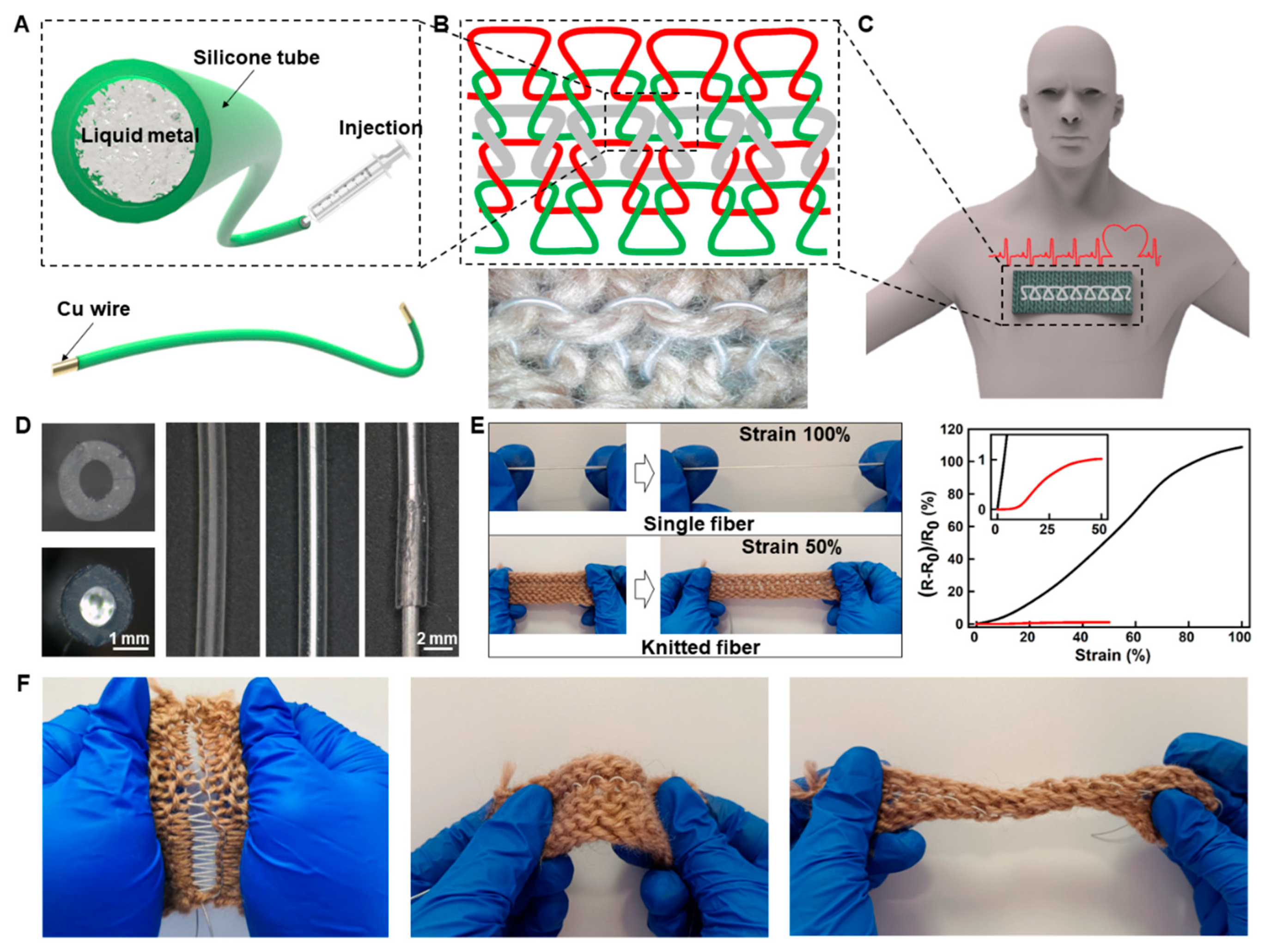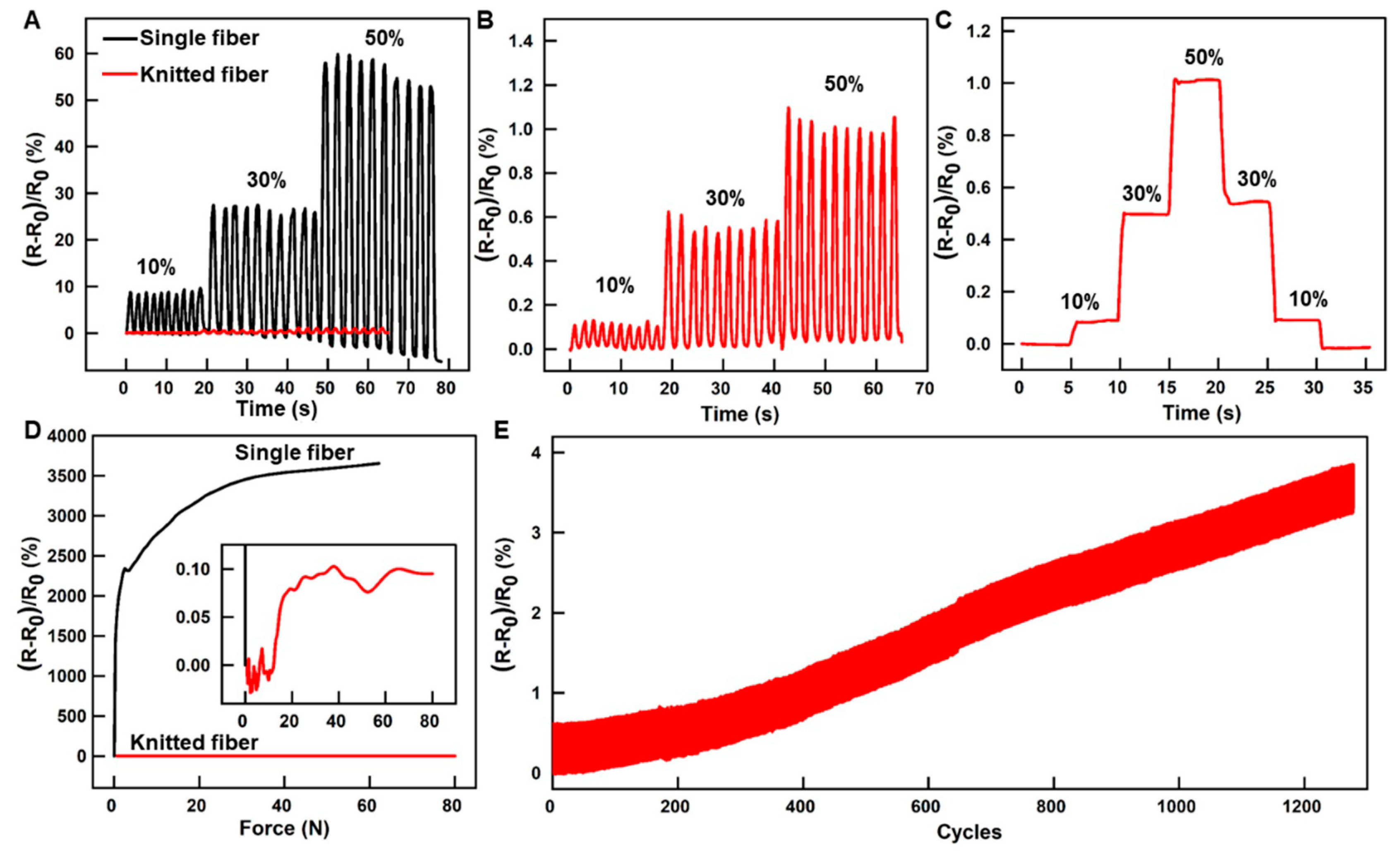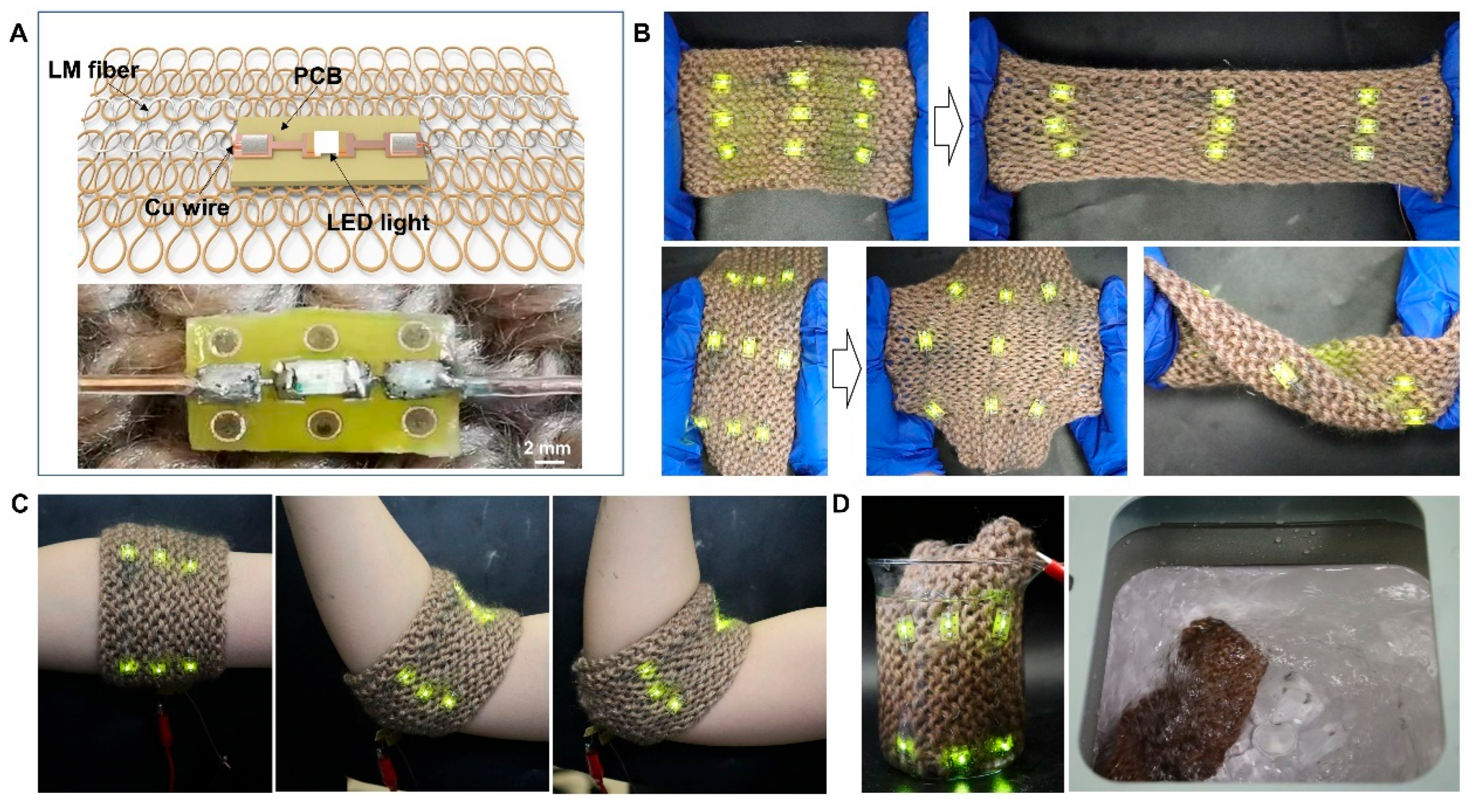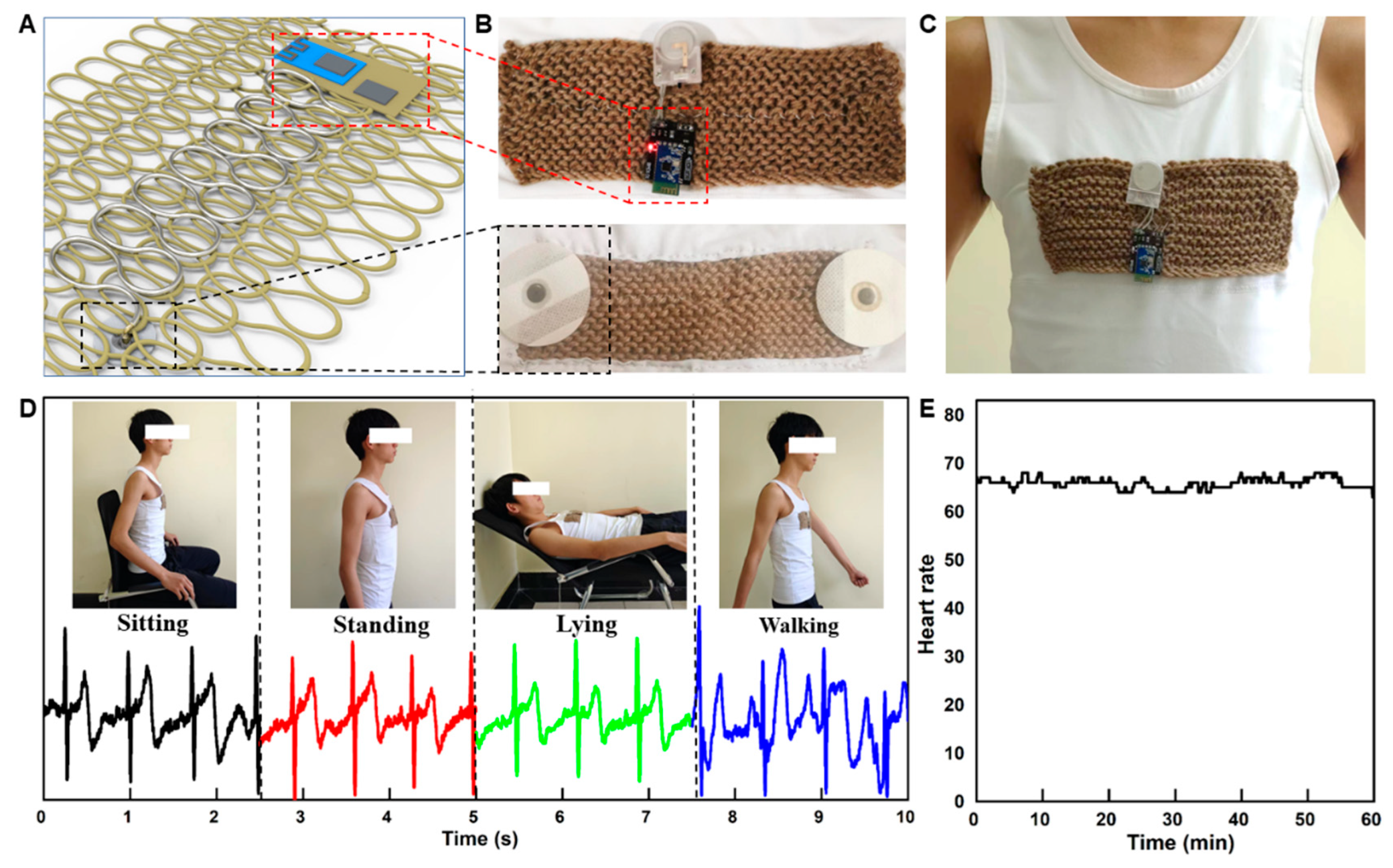Liquid Metal Fibers with a Knitted Structure for Wearable Electronics
Abstract
:1. Introduction
2. Materials and Methods
2.1. Materials
2.2. Preparation Method of Liquid Metal Fibers
2.3. Characterization
2.4. ECG Acquisition Circuit
3. Results and Discussions
3.1. Preparation of Knitted Liquid Metal Fibers
3.2. Electrical and Mechanical Properties
3.3. Interconnection with Rigid Devices
3.4. Wearable ECG Monitoring System
4. Conclusions
Supplementary Materials
Author Contributions
Funding
Institutional Review Board Statement
Informed Consent Statement
Data Availability Statement
Conflicts of Interest
References
- Zhang, M.; Wang, C.; Wang, Q.; Jian, M.; Zhang, Y. Sheath-Core Graphite/Silk Fiber Made by Dry-Meyer-Rod-Coating for Wearable Strain Sensors. ACS Appl. Mater. Interfaces 2016, 8, 20894–20899. [Google Scholar] [CrossRef] [PubMed]
- Choi, S.; Park, J.; Hyun, W.; Kim, J.; Kim, J.; Lee, Y.B.; Song, C.; Hwang, H.J.; Kim, J.H.; Hyeon, T.; et al. Stretchable Heater Using Ligand-Exchanged Silver Nanowire Nanocomposite for Wearable Articular Thermotherapy. ACS Nano 2015, 9, 6626–6633. [Google Scholar] [CrossRef] [PubMed]
- Khan, Y.; Ostfeld, A.E.; Lochner, C.M.; Pierre, A.; Arias, A.C. Monitoring of Vital Signs with Flexible and Wearable Medical Devices. Adv. Mater. 2016, 28, 4373–4395. [Google Scholar]
- Huang, W.R.; He, Z.; Wang, J.L.; Liu, J.W.; Yu, S.H. Mass Production of Nanowire-Nylon Flexible Transparent Smart Windows for PM2.5 Capture. iScience 2019, 12, 333–341. [Google Scholar] [CrossRef] [Green Version]
- Lee, J.; Kwon, H.; Seo, J.; Shin, S.; Koo, J.H.; Pang, C.; Son, S.; Kim, J.H.; Jang, Y.H.; Kim, D.E.; et al. Conductive fiber-based ultrasensitive textile pressure sensor for wearable electronics. Adv. Mater. 2015, 27, 2433–2439. [Google Scholar] [CrossRef] [PubMed]
- Miyamoto, A.; Lee, S.; Cooray, N.F.; Lee, S.; Mori, M.; Matsuhisa, N.; Jin, H.; Yoda, L.; Yokota, T.; Itoh, A.; et al. Inflammation-free, gas-permeable, lightweight, stretchable on-skin electronics with nanomeshes. Nat. Nanotechnol. 2017, 12, 907–913. [Google Scholar] [CrossRef]
- Park, J.J.; Hyun, W.J.; Mun, S.C.; Park, Y.T.; Park, O.O. Highly stretchable and wearable graphene strain sensors with controllable sensitivity for human motion monitoring. ACS Appl. Mater. Interfaces 2015, 7, 6317–6324. [Google Scholar] [CrossRef] [PubMed]
- Zhang, M.; Wang, C.; Liang, X.; Yin, Z.; Xia, K.; Wang, H.; Jian, M.; Zhang, Y. Weft-Knitted Fabric for a Highly Stretchable and Low-Voltage Wearable Heater. Adv. Electron. Mater. 2017, 3, 1700193. [Google Scholar] [CrossRef]
- Zhang, M.; Wang, C.; Wang, H.; Jian, M.; Hao, X.; Zhang, Y. Carbonized Cotton Fabric for High-Performance Wearable Strain Sensors. Adv. Funct. Mater. 2017, 27, 1604795. [Google Scholar] [CrossRef]
- Ye, C.; Ren, J.; Wang, Y.; Zhang, W.; Qian, C.; Han, J.; Zhang, C.; Jin, K.; Buehler, M.J.; Kaplan, D.L.; et al. Design and Fabrication of Silk Templated Electronic Yarns and Applications in Multifunctional Textiles. Matter 2019, 1, 1411–1425. [Google Scholar] [CrossRef] [Green Version]
- Wang, H.; Wang, C.; Jian, M.; Wang, Q.; Xia, K.; Yin, Z.; Zhang, M.; Liang, X.; Zhang, Y. Superelastic wire-shaped supercapacitor sustaining 850% tensile strain based on carbon nanotube@graphene fiber. Nano Res. 2018, 11, 2347–2356. [Google Scholar] [CrossRef]
- Wang, K.; Frewin, C.L.; Esrafilzadeh, D.; Yu, C.; Wang, C.; Pancrazio, J.J.; Romero-Ortega, M.; Jalili, R.; Wallace, G. High-Performance Graphene-Fiber-Based Neural Recording Microelectrodes. Adv. Mater. 2019, 31, e1805867. [Google Scholar] [CrossRef] [PubMed]
- Sheng, L.; Zhang, J.; Liu, J. Diverse transformations of liquid metals between different morphologies. Adv. Mater. 2014, 26, 6036–6042. [Google Scholar] [CrossRef] [PubMed]
- Wang, Q.; Yu, Y.; Yang, J.; Liu, J. Fast Fabrication of Flexible Functional Circuits Based on Liquid Metal Dual-Trans Printing. Adv. Mater. 2015, 27, 7109–7116. [Google Scholar] [CrossRef] [PubMed]
- Zhu, S.; So, J.-H.; Mays, R.; Desai, S.; Barnes, W.R.; Pourdeyhimi, B.; Dickey, M.D. Ultrastretchable Fibers with Metallic Conductivity Using a Liquid Metal Alloy Core. Adv. Funct. Mater. 2013, 23, 2308–2314. [Google Scholar] [CrossRef]
- Choe, M.; Sin, D.; Bhuyan, P.; Lee, S.; Jeon, H.; Park, S. Ultrasoft and Ultrastretchable Wearable Strain Sensors with Anisotropic Conductivity Enabled by Liquid Metal Fillers. Micromachines 2022, 14, 17. [Google Scholar] [CrossRef]
- Guo, R.; Wang, H.; Sun, X.; Yao, S.; Chang, H.; Wang, H.; Liu, J.; Zhang, Y. Semiliquid Metal Enabled Highly Conductive Wearable Electronics for Smart Fabrics. ACS Appl. Mater. Interfaces 2019, 11, 30019–30027. [Google Scholar] [CrossRef]
- Tang, L.; Cheng, S.; Zhang, L.; Mi, H.; Mou, L.; Yang, S.; Huang, Z.; Shi, X.; Jiang, X. Printable Metal-Polymer Conductors for Highly Stretchable Bio-Devices. iScience 2018, 4, 302–311. [Google Scholar] [CrossRef]
- Chen, S.; Liu, J. Liquid metal printed electronics towards ubiquitous electrical engineering. Jpn. J. Appl. Phys. 2022, 61, SE0801. [Google Scholar] [CrossRef]
- Li, G.; Wu, X.; Lee, D.W. A galinstan-based inkjet printing system for highly stretchable electronics with self-healing capability. Lab Chip 2016, 16, 1366–1373. [Google Scholar] [CrossRef]
- Yun, G.; Tang, S.Y.; Sun, S.; Yuan, D.; Zhao, Q.; Deng, L.; Yan, S.; Du, H.; Dickey, M.D.; Li, W. Liquid metal-filled magnetorheological elastomer with positive piezoconductivity. Nat. Commun. 2019, 10, 1300. [Google Scholar] [CrossRef] [PubMed] [Green Version]
- Cooper, C.B.; Joshipura, I.D.; Parekh, D.P.; Norkett, J.; Mailen, R.; Miller, V.M.; Genzer, J.; Dickey, M.D. Toughening stretchable fibers via serial fracturing of a metallic core. Sci. Adv. 2019, 5, eaat4600. [Google Scholar] [CrossRef] [PubMed] [Green Version]
- Park, Y.G.; An, H.S.; Kim, J.Y.; Park, J.U. High-resolution, reconfigurable printing of liquid metals with three-dimensional structures. Sci. Adv. 2019, 5, eaaw2844. [Google Scholar] [CrossRef] [PubMed] [Green Version]
- Hashimoto, M.; Sato, T.; Taguchi, Y. Additive manufacturing method of electrothermal 4D bimorph microactuator. Sens. Actuators A Phys. 2023, 356, 114348. [Google Scholar] [CrossRef]
- Zhang, Q.; Roach, D.J.; Geng, L.; Chen, H.; Qi, H.J.; Fang, D. Highly stretchable and conductive fibers enabled by liquid metal dip-coating. Smart Mater. Struct. 2018, 27, 035019. [Google Scholar] [CrossRef]
- Guo, R.; Wang, H.; Chen, G.; Yuan, B.; Zhang, Y.; Liu, J. Smart semiliquid metal fibers with designed mechanical properties for room temperature stimulus response and liquid welding. Appl. Mater. Today 2020, 20, 2352–9407. [Google Scholar] [CrossRef]
- Wang, M.; Ma, C.; Uzabakiriho, P.C.; Chen, X.; Chen, Z.; Cheng, Y.; Wang, Z.; Zhao, G. Stencil Printing of Liquid Metal upon Electrospun Nanofibers Enables High-Performance Flexible Electronics. ACS. Nano 2021, 15, 19364–19376. [Google Scholar] [CrossRef]
- Cao, J.; Liang, F.; Li, H.; Li, X.; Fan, Y.; Hu, C.; Yu, J.; Xu, J.; Yin, Y.; Li, F.; et al. Ultra-robust stretchable electrode for e-skin: In situ assembly using a nanofiber scaffold and liquid metal to mimic water-to-net interaction. InfoMat 2022, 4, e12302. [Google Scholar] [CrossRef]
- Li, B.M.; Reese, B.L.; Ingram, K.; Huddleston, M.E.; Jenkins, M.; Zaets, A.; Reuter, M.; Grogg, M.W.; Nelson, M.T.; Zhou, Y.; et al. Textile-Integrated Liquid Metal Electrodes for Electrophysiological Monitoring. Adv. Healthc. Mater. 2022, 11, e2200745. [Google Scholar] [CrossRef]
- Zhou, L.Y.; Gao, Q.; Zhan, J.F.; Xie, C.Q.; Fu, J.Z.; He, Y. Three-Dimensional Printed Wearable Sensors with Liquid Metals for Detecting the Pose of Snakelike Soft Robots. ACS Appl. Mater. Interfaces 2018, 10, 23208–23217. [Google Scholar] [CrossRef]
- Wu, Y.-h.; Zhen, R.-m.; Liu, H.-z.; Liu, S.-q.; Deng, Z.-f.; Wang, P.-p.; Chen, S.; Liu, L. Liquid metal fiber composed of a tubular channel as a high-performance strain sensor. J. Mater. Chem. C 2017, 5, 12483–12491. [Google Scholar] [CrossRef]
- Lin, R.; Kim, H.J.; Achavananthadith, S.; Xiong, Z.; Lee, J.K.W.; Kong, Y.L.; Ho, J.S. Digitally-embroidered liquid metal electronic textiles for wearable wireless systems. Nat. Commun. 2022, 13, 2190. [Google Scholar] [CrossRef] [PubMed]
- Choi, D.Y.; Kim, M.H.; Oh, Y.S.; Jung, S.H.; Jung, J.H.; Sung, H.J.; Lee, H.W.; Lee, H.M. Highly Stretchable, Hysteresis-Free Ionic Liquid-Based Strain Sensor for Precise Human Motion Monitoring. ACS Appl. Mater. Interfaces 2017, 9, 1770–1780. [Google Scholar] [CrossRef] [PubMed]




Disclaimer/Publisher’s Note: The statements, opinions and data contained in all publications are solely those of the individual author(s) and contributor(s) and not of MDPI and/or the editor(s). MDPI and/or the editor(s) disclaim responsibility for any injury to people or property resulting from any ideas, methods, instructions or products referred to in the content. |
© 2023 by the authors. Licensee MDPI, Basel, Switzerland. This article is an open access article distributed under the terms and conditions of the Creative Commons Attribution (CC BY) license (https://creativecommons.org/licenses/by/4.0/).
Share and Cite
Ping, B.; Zhang, Z.; Liu, Q.; Li, M.; Yang, Q.; Guo, R. Liquid Metal Fibers with a Knitted Structure for Wearable Electronics. Biosensors 2023, 13, 715. https://doi.org/10.3390/bios13070715
Ping B, Zhang Z, Liu Q, Li M, Yang Q, Guo R. Liquid Metal Fibers with a Knitted Structure for Wearable Electronics. Biosensors. 2023; 13(7):715. https://doi.org/10.3390/bios13070715
Chicago/Turabian StylePing, Bingyi, Zihang Zhang, Qiushi Liu, Minghao Li, Qingxiu Yang, and Rui Guo. 2023. "Liquid Metal Fibers with a Knitted Structure for Wearable Electronics" Biosensors 13, no. 7: 715. https://doi.org/10.3390/bios13070715
APA StylePing, B., Zhang, Z., Liu, Q., Li, M., Yang, Q., & Guo, R. (2023). Liquid Metal Fibers with a Knitted Structure for Wearable Electronics. Biosensors, 13(7), 715. https://doi.org/10.3390/bios13070715




